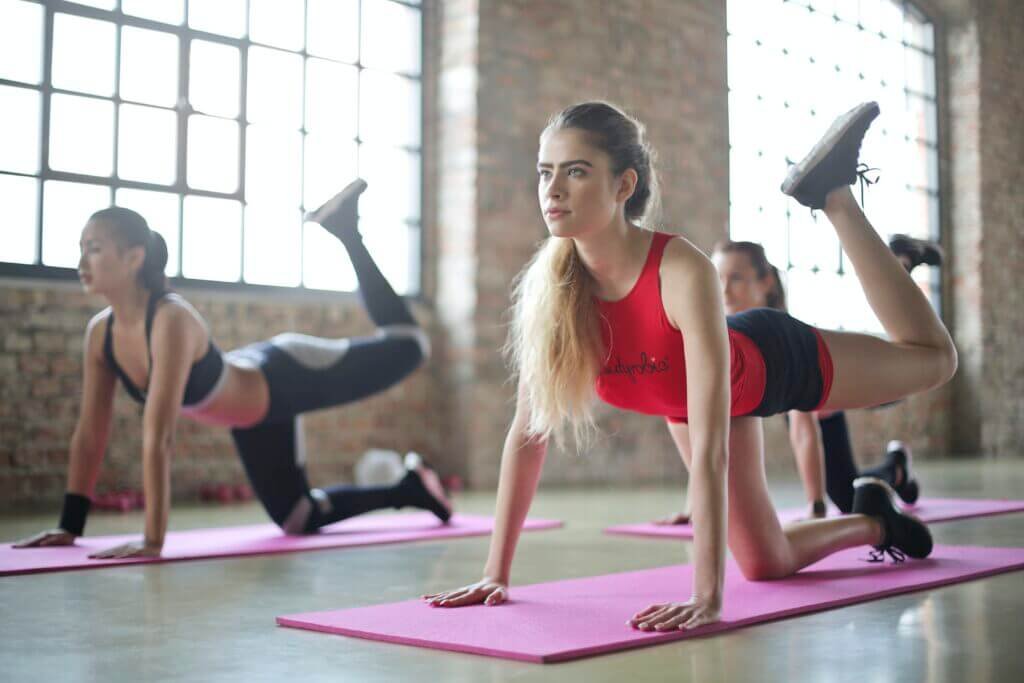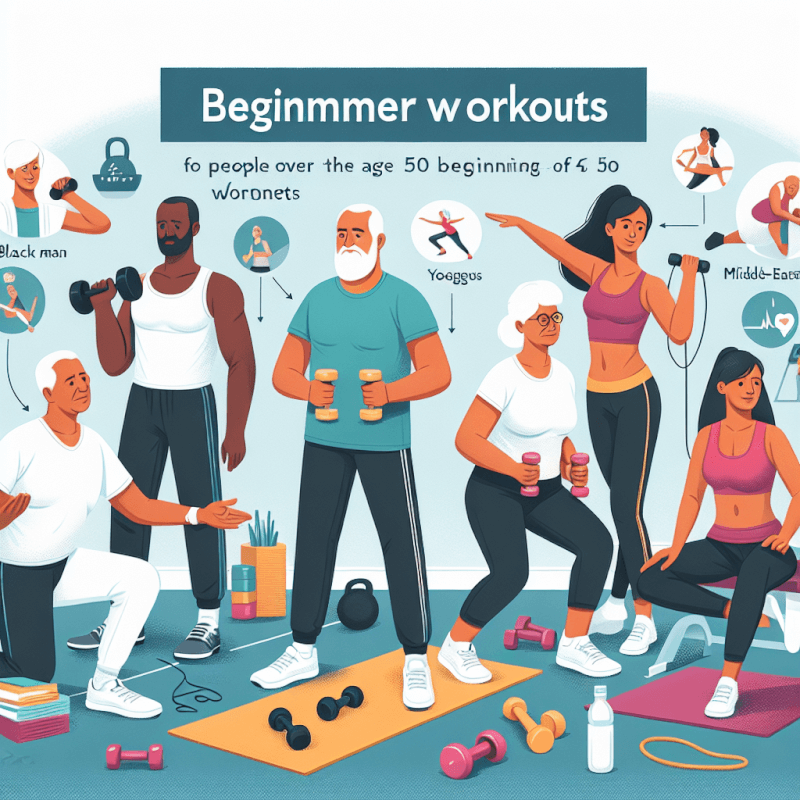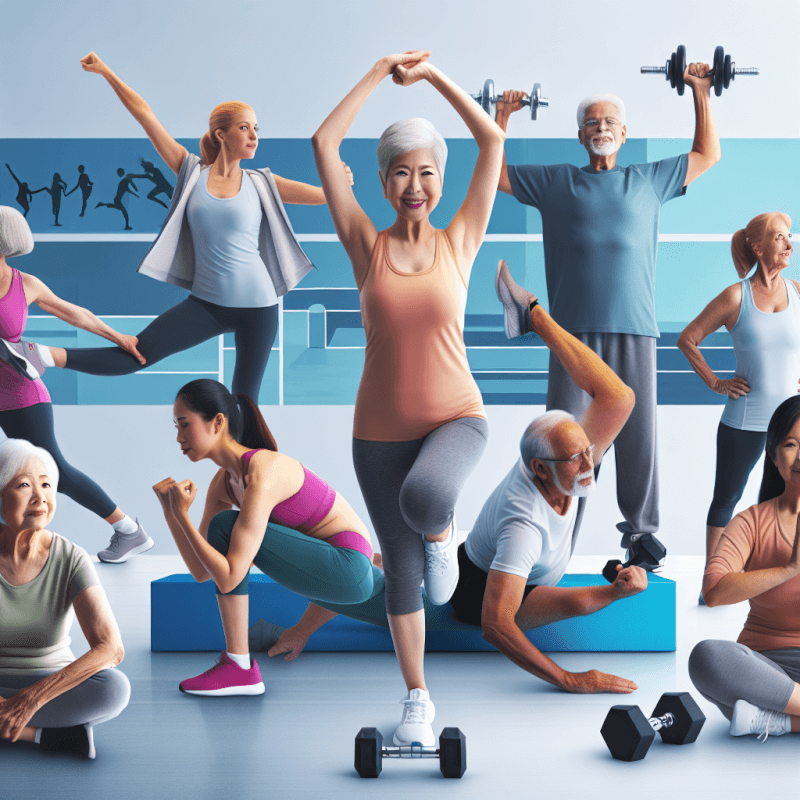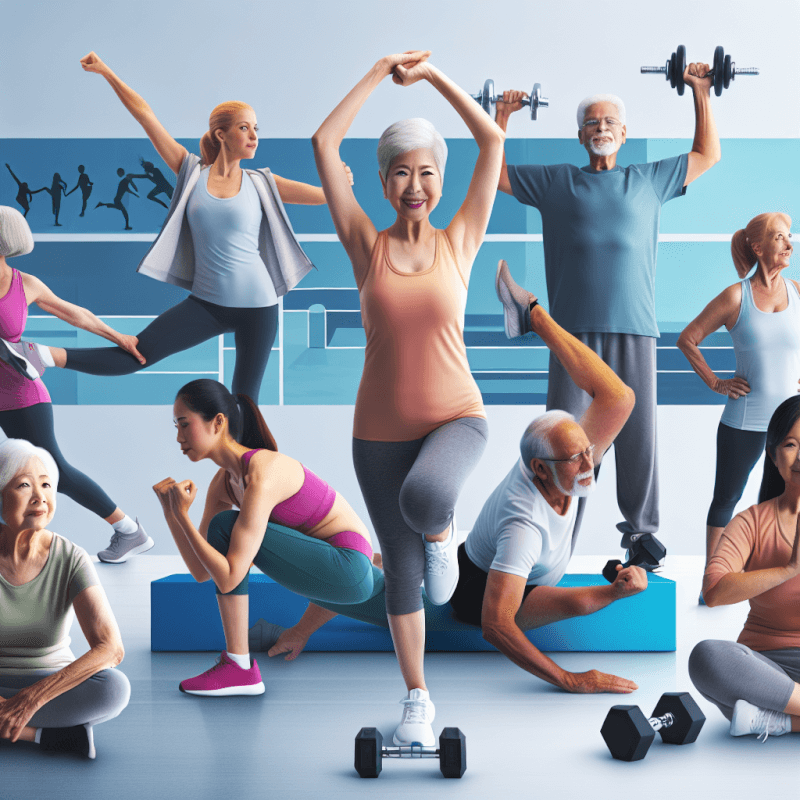Congratulations on taking the first step towards a healthier and fitter lifestyle! In this article, we will guide you through an easy and effective beginner workout designed specifically for individuals over 50. Whether you’re looking to increase your strength, improve your flexibility, or boost your overall fitness, this workout routine is tailored to suit your needs. Say goodbye to any concerns about age or fitness level, as we provide you with a friendly and approachable fitness plan that will help you feel stronger, more energized, and ready to take on any challenge that comes your way.
1. Importance of Exercise for Older Adults
As you age, staying active and incorporating exercise into your routine becomes increasingly important. Regular exercise offers numerous benefits for older adults, both physically and mentally. Not only does exercise help to maintain a healthy weight and prevent chronic diseases, but it also improves mood, boosts energy levels, and enhances cognitive function. Engaging in physical activity can also reduce the risk of falls, improve balance and flexibility, and increase overall strength and endurance.
1.1 Benefits of Exercise
Exercise provides a wide range of benefits for older adults. It helps to maintain healthy bones, muscles, and joints, reducing the risk of osteoporosis and arthritis. Regular physical activity also improves cardiovascular health by reducing the risk of heart disease, high blood pressure, and stroke. Exercise has also been shown to enhance mental well-being by reducing the symptoms of anxiety and depression, as well as improving memory and cognitive function.
1.2 Exercise Guidelines for Older Adults
When engaging in exercise, it is important to follow specific guidelines tailored for older adults. The American Heart Association recommends that adults aged 65 and older aim for at least 150 minutes of moderate-intensity aerobic activity per week or 75 minutes of vigorous-intensity aerobic activity. This can be achieved through activities such as brisk walking, swimming, or cycling. Additionally, older adults should perform strength training exercises targeting all major muscle groups at least two days per week.
1.3 Safety Considerations
While exercise offers numerous benefits for older adults, it is crucial to prioritize safety during workouts. Before starting any exercise regimen, it is recommended to consult with a healthcare provider, especially if you have any pre-existing medical conditions or concerns. It is important to listen to your body and start slowly, gradually increasing the intensity and duration of workouts. In addition, proper warm-up and cool-down exercises should always be incorporated to prevent injury. Taking breaks when needed and staying hydrated is also essential for maintaining safety during exercise.
2. Choosing the Right Exercises
When designing a workout routine for older adults, it is important to include a variety of exercises that target different aspects of fitness. This includes cardiovascular exercises, strength training, and flexibility and balance exercises.
2.1 Cardiovascular Exercises
Cardiovascular exercises, also known as aerobic exercises, are activities that elevate your heart rate and increase breathing. These exercises improve the health of your heart and lungs, increase endurance, and burn calories. Examples of cardiovascular exercises suitable for older adults include brisk walking, swimming, cycling, dancing, and water aerobics. Aim for at least 30 minutes of moderate-intensity cardiovascular exercise on most days of the week.
2.2 Strength Training
Strength training exercises are vital for maintaining muscle mass, preventing age-related muscle loss, and improving overall strength and mobility. It is recommended to engage in strength training activities that target all major muscle groups, such as lifting weights, using resistance bands, or using weight machines. Start with lighter weights and gradually increase the resistance as your strength improves. Aim for two or more days per week of strength training exercises.
2.3 Flexibility and Balance Exercises
Flexibility and balance exercises are essential for maintaining mobility, preventing falls, and improving posture. Incorporate stretching exercises that target major muscle groups, such as yoga or Pilates. Additionally, balance exercises such as standing on one leg, heel-to-toe walking, or Tai Chi can help improve stability and reduce the risk of falls. Perform these exercises at least two days per week, focusing on improving range of motion and balance.

3. Sample Beginner Workout Routine
To get started with a beginner workout routine, it is important to incorporate exercises from each category: warm-up exercises, cardiovascular exercises, strength training exercises, flexibility and balance exercises, and cool-down exercises. Here is a sample workout routine to help you get started:
3.1 Warm-up Exercises
Begin with a 5-10 minute warm-up to prepare your body for exercise. This can include marching in place, shoulder rolls, gentle stretching, and light cardiovascular movements such as walking or stationary cycling.
3.2 Cardiovascular Exercises
Choose an activity that elevates your heart rate and gets you moving for a sustained period. This can include brisk walking, cycling, swimming, or using an elliptical machine. Aim for 30 minutes of moderate-intensity cardiovascular exercise. If you are just starting out, you can break this into shorter intervals, gradually increasing your workout duration over time.
3.3 Strength Training Exercises
Engage in strength training exercises that target all major muscle groups. This can include exercises such as squats, lunges, bicep curls, shoulder presses, and chest presses. Start with lighter weights or resistance bands and gradually increase the resistance as your strength improves. Aim for two or more days per week of strength training exercises, performing two sets of 8-12 repetitions for each exercise.
3.4 Flexibility and Balance Exercises
Incorporate stretching exercises that target major muscle groups, such as yoga or Pilates. Additionally, practice balance exercises such as standing on one leg or heel-to-toe walking. Perform these exercises at least two days per week, focusing on improving range of motion and balance.
3.5 Cool-down Exercises
Finish your workout with a 5-10 minute cool-down to gradually decrease your heart rate and allow your body to recover. This can include gentle stretching, deep breathing exercises, and light walking.
4. Exercise Modifications and Progressions
As you continue with your workout routine, it is important to modify exercises to meet your individual needs and progress gradually over time.
4.1 Modifying Exercises for Individual Needs
If you have any physical limitations or health concerns, it is important to modify exercises to ensure safety and prevent injury. For example, if you have knee pain, you can choose low-impact cardio exercises such as swimming or cycling instead of jogging. Modify strength training exercises by using resistance bands or lighter weights to accommodate your current strength level. Always listen to your body, and if an exercise causes pain or discomfort, consult with a healthcare provider or certified personal trainer for appropriate modifications.
4.2 Progressing the Workout Routine
Once you have established a baseline level of fitness, it is important to progressively increase the intensity and duration of your workouts. Gradually increase the resistance or weight used in strength training exercises to continue challenging your muscles. Increase the duration or intensity of cardiovascular exercises to further improve endurance. Remember to always give your body time to adapt and recover between workouts and avoid overexertion.

5. Tips for Staying Motivated and Consistent
Maintaining motivation and consistency with your workout routine can sometimes be challenging. Here are some tips to help you stay on track:
5.1 Setting Realistic Goals
Set realistic and achievable goals to keep you motivated. Whether it is completing a certain number of workouts per week or reaching a specific fitness milestone, having clear goals can help keep you focused and motivated.
5.2 Finding an Exercise Buddy
Partnering up with a friend or family member can make exercise more enjoyable and help hold you accountable. Having someone to exercise with provides social support and can make the workout session more enjoyable.
5.3 Tracking Progress
Keep track of your workouts, progress, and achievements. This can be done through a workout journal or using a fitness app. Seeing your progress over time can be highly motivating and help you stay committed to your exercise routine.
5.4 Celebrating Milestones
Celebrate your achievements along the way. Whether it’s reaching a weight loss goal, improving your strength, or completing a challenging workout, take the time to acknowledge and celebrate your progress. Treat yourself to a healthy reward or engage in a favorite activity to stay motivated and positive.
6. Importance of Proper Nutrition
In addition to exercise, proper nutrition plays a crucial role in overall health and well-being, especially as you age. Good nutrition provides the body with essential nutrients, supports optimal energy levels, and helps with muscle recovery and repair.
6.1 Balanced Diet
Maintaining a balanced diet is important for older adults. This includes consuming a variety of fruits, vegetables, whole grains, lean proteins, and healthy fats. Aim for a diet that is rich in vitamins, minerals, and antioxidants to support overall health and well-being.
6.2 Nutrient Timing
Timing your meals and snacks can also have a significant impact on your energy levels and exercise performance. It is important to fuel your body with a balanced meal or snack before and after workouts to provide the necessary energy and nutrients for optimal performance and recovery.
6.3 Hydration
Staying hydrated is essential for overall health and exercise performance. As an older adult, it is important to pay attention to your hydration levels and drink water throughout the day, especially during and after exercise. Adequate hydration helps regulate body temperature, lubricate joints, and transport nutrients.

7. Rest and Recovery
While regular exercise is important, it is equally important to prioritize rest and recovery to allow your body to repair and rebuild. Rest and recovery are essential for preventing overtraining, reducing the risk of injury, and optimizing exercise performance.
7.1 Importance of Rest Days
Incorporate rest days into your exercise routine to allow your muscles and body to recover between workouts. Rest days give your muscles time to repair and adapt, reducing the risk of overuse injuries and improving overall performance.
7.2 Sleep and Recovery
Getting adequate sleep is crucial for overall health and exercise recovery. Aim for 7-9 hours of quality sleep per night to support optimal physical and mental well-being. Sleep is when your body repairs and rejuvenates itself, helping you feel refreshed and energized for your next workout.
7.3 Listening to Your Body
Pay attention to your body and how it feels during and after exercise. If you experience pain, fatigue, or excessive soreness, it may be a sign that you need to adjust your exercise routine or take a rest day. It is important to listen to your body’s signals and make modifications when necessary to prevent injury and promote optimal recovery.
8. Common Mistakes to Avoid
To ensure a safe and effective exercise routine, it is important to avoid common mistakes that can hinder your progress and increase the risk of injury.
8.1 Overexertion
Pushing yourself too hard and overexerting can lead to burnout, fatigue, and increased risk of injury. Gradually increase the intensity and duration of your workouts to give your body time to adapt and avoid overexertion.
8.2 Ignoring Pain
Never ignore pain during exercise. Pain is your body’s way of signaling that something is wrong. If you experience pain, discomfort, or unusual symptoms, stop exercising and consult with a healthcare provider or certified personal trainer for guidance.
8.3 Neglecting Warm-up and Cool-down
Skipping warm-up and cool-down exercises can increase the risk of injury and decrease exercise performance. Always include a proper warm-up to prepare your body for exercise and a cool-down to gradually decrease your heart rate and allow for recovery.
8.4 Neglecting Balance and Flexibility Training
Balance and flexibility are crucial components of fitness, especially for older adults. Neglecting these aspects of fitness can increase the risk of falls and limit mobility. Incorporate regular balance and flexibility exercises into your routine to improve stability and range of motion.
8.5 Lack of Consistency
Consistency is key when it comes to exercise. Skipping workouts or not sticking to a regular routine can hinder progress and diminish the benefits of exercise. Find a schedule and routine that works for you and make exercise a priority in your daily life.

9. Importance of Seeking Professional Guidance
If you are unsure about how to start or progress with your exercise routine, it is always a good idea to seek professional guidance.
9.1 Consulting with a Healthcare Provider
Before starting any exercise program, it is important to consult with a healthcare provider, especially if you have any pre-existing medical conditions or concerns. They can provide guidance based on your individual needs and ensure that exercise is safe and appropriate for you.
9.2 Working with a Certified Personal Trainer
A certified personal trainer can provide guidance and create a customized exercise program tailored to your needs and goals. They can ensure that you are performing exercises correctly, provide motivation and support, and help you progress safely.
9.3 Joining Group Exercise Classes
Joining group exercise classes can be a great way to stay motivated and enjoy the social aspect of exercise. Many fitness centers and community centers offer specialized exercise classes for older adults, such as water aerobics, yoga, or senior fitness classes. These classes are led by qualified instructors who can provide modifications and ensure safety during exercise.
10. Conclusion
Starting a beginner workout routine is a great way for older adults to improve their overall health and well-being. Regular exercise offers numerous benefits, including improved cardiovascular health, increased strength and mobility, enhanced mental well-being, and reduced risk of falls. By incorporating a variety of exercises into your routine, listening to your body, and following proper safety guidelines, you can effectively and safely enjoy the benefits of exercise at any age. Remember, it is never too late to start and taking the first step towards a healthier and more active lifestyle can have a profound impact on your quality of life.



